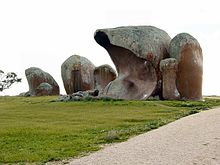Murphys Haystacks

They are of a 'tumulus' form of weathered granite outcrop. They are made of a pink, massive, coarsely equigranular rock consisting mostly of quartz and orthoclase. Their appearance may be due to a combination of erosion by underground rainwater and then by subsequent weathering after they were exposed. Most of the pillars emerge without a break from the underlying granite. Their structural base may be of orthogonal or vertically-aligned sheet jointing.
They obtained their name because a traveller in a coach saw the formation in the distance. He asked how a farmer could produce so much hay. As the farm was on a property owned by a man called Murphy, the rocks became known as Murphy's Haystacks.
The site is listed on the South Australian Heritage Register.

References
- ^ "Murphy's Haystacks". Google Maps. Retrieved 14 February 2016.
- ^ Main, B York (September 1997). "Granite outcrops: A collective ecosystem" (PDF). Journal of the Royal Society of Western Australia. 80 (3). Department of Zoology, University of Western Australia: 115. Retrieved 4 April 2017.
- ^ Twidale, C. R.; Campbell, Elizabeth M. (1984). "Murphy Haystacks, Eyre Peninsula, South Australia". Transactions of the Royal Society of South Australia. 108 (4): 175, 177–9. Retrieved 24 April 2017.
- ^ White, Melissa (31 December 2008). "Prioritising rock-holes of Aboriginal and ecological significance in the Gawler Ranges" (PDF). Knowledge and Information Division Department of Water, Land and Biodiversity Conservation. p. 17. Retrieved 24 April 2017.
- ^ "Murphys Haystacks in SA". Australian Broadcasting Corporation. 26 July 2007. Retrieved 3 October 2014.
- ^ "Murphy's Haystacks, Eyre Peninsula, South Australia". Steve Wade. 2002. Archived from the original on 20 August 2008. Retrieved 3 October 2014.
- ^ "Murphy's Haystacks Geological Site". South Australian Heritage Register. Department of Environment, Water and Natural Resources. Retrieved 14 February 2016.